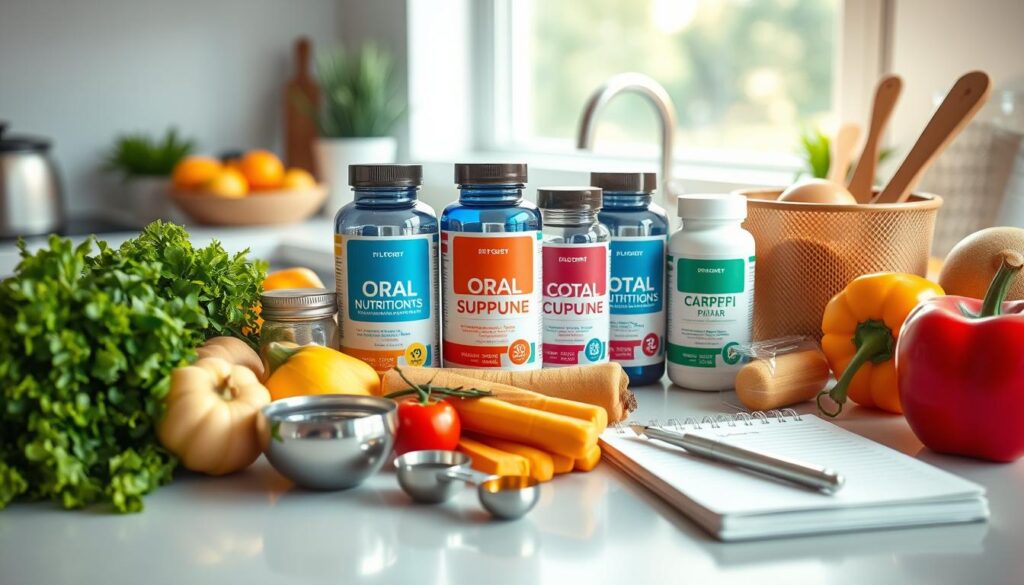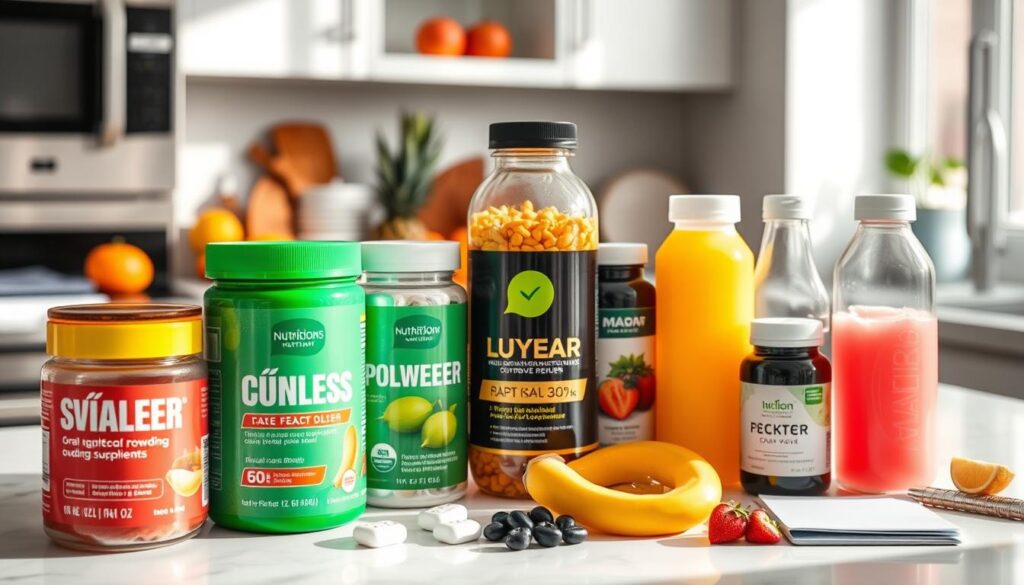Oral nutritional supplements are key in modern dietetics. They help patients who can’t get enough nutrients from food alone. It’s important to prescribe them correctly for the best support and to save money on healthcare.
In England and Wales, we spend about £187 million a year on ONS. This shows how crucial it is to prescribe them right. Healthcare workers, like dietitians, need to know a lot about nutrition to help patients well.

The National Institute for Health and Care Excellence (NICE) suggests using tools to check if someone might be malnourished. The Malnutrition Universal Screening Tool (MUST) is used a lot in the NHS. It helps find who might need help with nutrition, like ONS.
It’s not the same for everyone when it comes to ONS. Patients have to meet certain rules set by the Advisory Committee on Borderline Substances (ACBS) to get them. Conditions like short bowel syndrome, hard-to-absorb diseases, and malnutrition due to illness often need ONS.
Key Takeaways
- ONS prescribing requires meeting specific ACBS criteria
- MUST is a widely used tool for assessing malnutrition risk
- Healthcare professionals need proper nutrition education
- ONS prescriptions should be regularly reviewed
- Appropriate ONS use can lead to significant healthcare savings
Understanding Malnutrition and Nutritional Risk Assessment
Malnutrition is a big problem in healthcare. Studies show 20-50% of patients are malnourished or at high risk when they first come to the hospital. This shows we need good tools to check nutritional risk.
Defining Malnutrition in Clinical Settings
Malnutrition happens when someone doesn’t get enough nutrients. It can harm their body’s shape and how it works. Sadly, in hospitals, only 52% screen for malnutrition regularly.
The Malnutrition Universal Screening Tool (MUST)
The MUST score is a common way to check nutritional risk. It looks at BMI and weight loss. Here’s how MUST scoring works:
| MUST Score | Risk Level | Action |
|---|---|---|
| 0 | Low Risk | Routine care |
| 1 | Medium Risk | Close monitoring |
| 2 or more | High Risk | Nutritional intervention |
Risk Factors and Clinical Indicators
Things that raise malnutrition risk include a low BMI, losing more than 10% of body weight in 3-6 months, and poor nutrient absorption. Signs like trouble chewing, being unable to move, and side effects from medicines also matter. A full check-up helps spot who’s at risk and what to do next.
Who Can Prescribe Nutritional Supplements
It’s important to know who can prescribe oral nutritional supplements (ONS) for patient care. Dietitians are key in nutrition management but can’t prescribe medications or supplements.
Healthcare Professionals’ Roles in ONS Prescribing
Registered dietitians (RDs) are nutrition experts. They check dietary needs, create nutrition plans, and teach patients. They work with doctors to help patients through diet.
RDs can suggest supplements but can’t prescribe them or medications.
Prescribing Authority and Guidelines
In the United States, only certain healthcare professionals can prescribe ONS. These include licensed doctors, nurse practitioners, and physician assistants. They have the training and legal right to do so.
| Professional | Can Prescribe ONS | Can Recommend ONS |
|---|---|---|
| Medical Doctors (MDs) | Yes | Yes |
| Doctors of Osteopathic Medicine (DOs) | Yes | Yes |
| Nurse Practitioners (NPs) | Yes | Yes |
| Physician Assistants (PAs) | Yes | Yes |
| Registered Dietitians (RDs) | No | Yes |
Referral Pathways to Dietitians
Healthcare providers often send patients to dietitians for nutritional care. The nutritional support team includes dietitians working with prescribing doctors. The referral criteria can change by location.
But, patients with high nutritional risk scores are often sent to dietitians for detailed assessment and management.
Dietitians can’t prescribe but are crucial in deciding if ONS are needed. They work with doctors to make sure patients get the right nutritional support in their treatment plan.
Clinical Criteria for ONS Prescription
The NHS has strict rules for Oral Nutritional Supplements (ONS) prescriptions. These rules are based on how much a patient needs and their nutritional status. The Advisory Committee on Borderline Substances (ACBS) criteria are key in deciding who gets ONS on the NHS.
To get ONS on the NHS, patients must meet certain ACBS criteria. They must be malnourished or at risk of it, as NICE guidelines say. Sadly, up to 75% of ONS prescriptions might not be right when checked against ACBS criteria and best practices.
Patients need to have one or more ACBS indications to get ONS. Before getting ONS, food fortification should be tried for at least a month. This “food first” approach is recommended by NICE and can be more varied and cost-effective.
- Malnutrition risk screening is essential in primary and secondary care settings
- ONS prescriptions for specific patient groups require specialist input
- National audits highlight the need to address inappropriate ONS prescribing
How well patients stick to ONS prescriptions varies. Studies show mean adherence rates of 76% to 93%. Taste preferences and patient involvement in flavor selection can affect this. Proper assessment of clinical need and patient engagement can make ONS prescriptions more effective and better use NHS resources.
The ‘Food First’ Approach Before ONS
Before giving oral nutritional supplements, doctors often suggest a ‘food first’ approach. This method aims to improve nutrition through natural foods and fortification.
Dietary Fortification Techniques
Food fortification adds extra nutrients to meals to increase calories and protein. Here are some common ways to do it:
- Adding butter or olive oil to vegetables
- Using full-fat dairy products in cooking
- Incorporating cheese into savory dishes
- Adding cream to soups and desserts
| Food Item | Calories | Protein (g) |
|---|---|---|
| Butter (1 tbsp) | 104 | 0.1 |
| Cheese (30g) | 121 | 8 |
| Olive oil (1 tbsp) | 119 | 0 |
| Skimmed Milk powder (25g) | 124 | 7 |
High-Protein and High-Calorie Food Options
Adding high-calorie foods to your diet can boost energy. Some good choices are:
- Nuts and seeds
- Avocados
- Fatty fish
- Whole grains
- Lean meats
Homemade Nutritional Drinks
Homemade drinks can be a great way to get more calories and nutrients. Try blending fruits, yogurt, milk, and nut butters for a tasty smoothie. Adding protein powder or skimmed milk powder can increase protein.
It’s important to tailor dietary advice to each person’s needs and likes. A balanced approach to fortifying food ensures patients get enough nutrition and enjoy their meals.
Types and Forms of Oral Nutritional Supplements
Oral Nutritional Supplements (ONS) come in many forms to fit different needs. The main types are powdered ONS, ready-to-drink ONS, and compact ONS. Each type helps support nutritional intake in its own way.
Powdered ONS are a common choice. They can be mixed with milk or water to make a drink full of nutrients. Ready-to-drink ONS are easy to use, needing no prep. Compact ONS pack a lot of nutrition into a small amount, perfect for those who find big portions hard to manage.
Milkshake-style ONS are loved for their taste and texture. There are also juice-style, yogurt-style, and soup-style supplements. Some are made for specific needs, like those with swallowing problems or kidney disease.
| ONS Type | Volume Range (ml) | Energy Density (kcal/ml) | Special Features |
|---|---|---|---|
| Juice-style | 200-220 | 1.25-1.5 | Fat-free |
| Milkshake-style | 125-220 | 1-2.4 | May contain added fiber |
| High-energy powders | 125-350 | 1.5-2.5 | Mixed with full cream milk |
| Compact (shots) | 30-40 | High concentration | Taken 3-4 times daily |
The right ONS depends on many things. These include nutritional needs, health conditions, and personal likes. Doctors and healthcare teams look at these factors to pick the best supplement for each patient.
Powdered vs Ready-to-Drink ONS Options
Oral Nutritional Supplements (ONS) come in two main forms: powders and ready-to-drink liquids. Each type has its benefits, catering to different patient needs and preferences.
First-Line Powdered Supplements
Powdered ONS are often the first choice due to their cost-effectiveness. Products like Aymes Shake, Complan Shake, and Foodlink Complete are mixed with 200ml whole milk. These supplements provide about 383 calories and 19g of protein per serving.
Second-Line Ready-to-Drink Products
Ready-to-drink options are convenient for patients who struggle with preparation. Altraplen Energy, Fortisip Bottle, and similar products offer 300 calories per 200ml bottle. These are typically lactose-free, making them suitable for those with lactose intolerance.
Compact Formula Options
For patients who can’t tolerate large volumes, compact ONS options are available. Products like Aymes Shake Compact and Altraplen Compact provide high nutrition in smaller servings, ideal for those with fluid restrictions.
| ONS Type | Example | Calories | Protein | Volume |
|---|---|---|---|---|
| Powdered | Aymes Shake | 383 | 19g | 200ml |
| Ready-to-Drink | Fortisip Bottle | 300 | 12g | 200ml |
| Compact | Altraplen Compact | 300 | 12g | 125ml |

Choosing between powdered and liquid ONS depends on factors like patient preference, preparation ability, and compliance. Healthcare providers typically start with a 7-10 day supply to test acceptability before long-term prescription.
Prescribing Quantities and Duration
Healthcare providers should start with starter packs or one-week supplies of oral nutritional supplements (ONS). This method reduces waste and lets patients try different flavors. The usual dose is two sachets or bottles a day, which is effective.
How long a patient takes ONS is key. Instead of adding it to ongoing prescriptions, doctors should write new ones. This helps keep track of how well the patient is doing and makes it easier to change the treatment plan if needed.
For the best results, patients should take ONS with meals or right after. This way, it doesn’t get in the way of eating and keeps hunger for meals. Remember, supplements must be swallowed, not rubbed on the skin or breathed in, to count as such.
- Prescribe starter packs or one-week supplies initially
- Recommend two sachets or bottles daily for clinical effectiveness
- Use acute prescriptions to encourage regular review
- Advise patients to take ONS between or after meals
By sticking to these rules, doctors can make sure patients get the right amount of ONS. This helps make sure the treatment works well and is used right.
Monitoring and Review of ONS Prescriptions
It’s important to regularly check how well Oral Nutritional Supplements (ONS) are working. This means checking in often and making changes as needed based on how the patient is doing.
Assessment Frequency
Checking ONS prescriptions every month is key. These checks include looking at the patient’s weight and reassessing the MUST score. Patients or their caregivers should report their weight every three months. This helps update the MUST score before the ONS prescription is renewed.
Treatment Goals and Outcomes
The main goals for using ONS are to help patients gain weight and improve their nutrition. A study found that frail elderly patients who took oral supplements for 12 weeks gained more weight than those who didn’t. ONS can also help prevent wound breakdown by 70% and lower death rates by 40% in malnourished patients.
Discontinuation Criteria
Stop using ONS when patients can eat enough and keep their weight up. After leaving dietitian care, keep checking for malnutrition every three months. This makes sure ONS are only used when really needed, saving money and preventing waste.
| Monitoring Aspect | Frequency | Action |
|---|---|---|
| Prescription Review | Monthly | Re-screen and assess clinical need |
| Weight Monitoring | Every 3 months | Document in patient records |
| MUST Score | Before prescription renewal | Recalculate based on current weight |
| Malnutrition Status | Every 3 months post-discharge | Assess ongoing need for ONS |
Special Considerations in ONS Prescribing
When prescribing oral nutritional supplements (ONS), it’s important to think about each patient’s specific needs. This part looks at what to consider for patients with kidney issues, those in end-of-life care, and those with swallowing problems.
Renal Disease Patients
Patients with advanced kidney disease (stage 4 and above) need special nutrition care. Powdered ONS might not be good for them because of possible electrolyte imbalances and fluid limits. These patients should see a Dietetic Service for a nutrition plan made just for them.
End-of-Life Care
In palliative care, ONS can help keep patients comfortable. Even if they can’t eat enough to keep their weight up, a good nutrition plan can offer comfort. The goal is to manage symptoms and improve overall well-being, not just to gain weight.
Dysphagia Management
Patients with swallowing problems need extra care. Before giving ONS, it’s key to refer them to Speech and Language Therapy. Also, remember not to mix ONS with thickeners, as it can change the supplement’s nutritional value and effectiveness.

| Patient Group | ONS Considerations | Recommended Action |
|---|---|---|
| Renal Disease (Stage 4+) | Avoid powdered ONS | Refer to Dietetic Service |
| Palliative Care | Focus on quality of life | Tailor nutrition plan |
| Dysphagia | Avoid mixing ONS with thickeners | Consult Speech and Language Therapy |
By considering these special needs, healthcare professionals can make sure ONS prescriptions are safe and meet each patient’s unique needs.
Cost-Effective Prescribing Strategies
Managing ONS costs is crucial. A West Midlands study showed big increases in enteral feed costs and volumes from 1994 to 1997. Healthcare providers should look for cheaper options and ways to reduce waste.
Doctors should only use starter packs of powdered ONS for the first time. These packs come with shaker devices, adding extra costs. Also, low-calorie ONS are not cost-effective.
Continuous professional development (CPD) for drug prescribing can save a lot of money. A study of 38 CPD programs found a median drug cost savings of $79,373. The educational costs ranged from $281 to $183,554. Most studies showed that CPD leads to lower healthcare costs.
| CPD Metric | Value |
|---|---|
| Median Drug Cost Savings | $79,373 |
| Educational Cost Range | $281 – $183,554 |
| Median Educational Cost | $15,664 |
| Studies Showing Reduced Costs | 94% |
By using these strategies and investing in prescriber education, healthcare systems can cut down on ONS-related expenses. This way, they can keep quality patient care without breaking the bank.
Managing Hospital Discharge and ONS Continuation
Hospital discharge is a big step in patient care. It’s important to manage oral nutritional supplements (ONS) well during this time. This helps patients recover and stay healthy.
Communication Between Care Settings
Good communication between hospital staff and community healthcare is vital. A study found that better discharge planning cut hospital readmissions by 11% in three months.
Review of Hospital Prescriptions
Checking hospital prescriptions carefully is crucial. Research shows 40% of hospital food is not eaten. This means tailored nutritional plans are key to meet patient needs.
| Aspect | Impact |
|---|---|
| Discharge Planning | 11% reduction in readmissions |
| Hospital Food Waste | 40% left uneaten |
| Nutritional Support | Improved body weight, reduced mortality |
Before leaving the hospital, a follow-up plan should be made. This plan should include regular checks on prescriptions and nutrition. Studies show that ongoing nutritional support can lead to better health, especially for older adults who are malnourished.
Remember, ONS should only continue after discharge if a dietitian recommends it. If no advice is received in two weeks, use tools like MUST to check the patient’s needs.
Conclusion
Using oral nutritional supplements (ONS) correctly is key to better health and saving money in healthcare. Dietitians are better at this than doctors, giving fewer wrong prescriptions. They also check lab work more often and follow up with patients more regularly.
Even though many people in the US take supplements, not all do so on their doctor’s advice. This shows we need more help from doctors and nutrition experts. People take supplements for many reasons, like staying healthy or looking better.
But, some think supplements can stop diseases, which isn’t always true. A study in Britain found no difference in heart disease risk between omega-3 users and those taking a placebo. An American study also found no benefit from fish oil supplements for heart health.
These studies remind us of the need for careful prescribing. Doctors should stick to what science says and focus on food first. This way, they can help patients stay healthy while keeping healthcare costs down.



